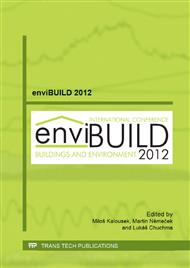p.3
p.7
p.11
p.15
p.19
p.25
p.29
p.33
Impact of Internal Thermal Insulation Systems on Static Behaviour of Exterior Walls
Abstract:
In general, in the climatic conditions of the Czech Republic the inner insulation of cladding structures is an unsuitable solution to reduce heat loss of building by means of heat transfer. This statement is valid both in terms of building thermal techniques and also in terms of statics. Research focused on the hygrothermal regime of external walls insulated on the inside is very extensive. On the other hand, the systematic attention is not yet paid to detailed analysis of the consequences of such solution on the static behavior of the cladding structures. The paper focuses on analysis and evaluation of stress increase in external walls and adjacent structures caused by non-forced effects of temperature changes in the environment after the application of internal insulation.
Info:
Periodical:
Pages:
11-14
Citation:
Online since:
January 2013
Authors:
Price:
Сopyright:
© 2013 Trans Tech Publications Ltd. All Rights Reserved
Share:
Citation:


